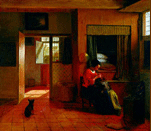










21.
Veiled Truths: Wives, Widows,
and Whores in Early Modern Europe
Organizers:
Description:
We do not take credit for our workshop's immediate appeal: by (Western) definition,
the idea of veiled women is inherently compelling. However, we do want to
explore and interrogate this appeal in early modern Europe by means of engaged
and informative scholarly discussion. To this end, we offer an
accessible range of short literary texts and vivid artistic images, and we
expect that participants will describe or bring their own primary documents
for group examination. We also anticipate that participants' historical, national,
and disciplinary expertise will broaden our preliminary focus on 17th-century
English poetry and on 16th-century Italian and early modern Germanic art.
We will begin with five or ten minutes of introduction, asking
participants to identify themselves and their interest in the workshop. We
will then move on to group discussion of the distributed materials. We propose
three 25-minute discussion periods, the first focusing on veils and marriage,
the second on
veils and widowhood, and the third on veils and prostitution. Our final minutes
will be devoted to making connections and distinctions among the various materials
considered in the three topical conversations.
Our first session, on veiling and marriage, will begin with a discussion of the poetry of Milton and Philips. The paradoxical state of veiled immanence that characterizes Adam and Eve as individuals--they walk in "naked Majesty" and yet "innocence . . . as a veil . . . shadow[s] them from knowing ill"--also characterizes their marriage. They reveal themselves fully to one another, verbally and sexually, and yet do so with an innocence that "shadows" or conceals their passion, as we see when Milton veils their lovemaking from voyeuristic readers in Book IV's bower. Or does he? Does Milton's veiling of conjugal relations serve to conceal or express sexual passion? Does it exclude and chasten or include and titillate the reader? These questions, which are at the heart of any poetics of marital chastity and which we will explore through group discussion of related cases, intensifies when we turn to Philips. Like Milton, Philips presents a poet-wife speaking from within a chaste marriage; unlike Milton's Eve, though, Philips' speaker refers to a marital union that she makes no attempt to display to the reader. The result are "veiled" (or even cloaked) poems that screen their intimacy from outsiders through an exclusive (and roblematically private) discourse. Our hope is that the Milton-Philips pairing, portraying as it does the problems of titillation on the one hand and unintelligibility on the other, will invite other complicating examples of marital veiling from participants.
Our second session, on veiling and widowhood, will begin with
an examination of late 15th- and early 16th-century portraits of Italian widows,
particularly Medici widows in Florence (e.g., Maria Salviati, Caterina Sforza).
In what ways does the widow's veil, as it is worn and portrayed in images
by Bronzino, Pontormo, and others, function as a social marker of mourning
and memory? What other agendas govern the ways in which widow's veils function
in these portraits? To the extent that veils serve as masks or masquerade,
what do they conceal and reveal, and for/from whom? Finally, how do representations
of veiled widows complicate the actual identities of both mourner and mourned?
For example, several portraits of wives as widows were commissioned prematurely
by husbands, even though, in cases where wives predeceased their husbands,
that role was never filled. What was the function of such portraits for husbands?
for wives? for artists? What agendas did they express, control,
betray? The focus of our discussion about widow's veils in Italy and elsewhere
will be on the complex interplay of social status, sartorial display and signification,
and pictorial representation.
Related issues will structure our final discussion, on veiling
and
prostitution, which will begin with a consideration of how veils were used
to construct women's sexual condition in German-speaking countries. Veils
of a specific shape and color were the identifying mark of harlots on South
German and Swiss towns; similarly, in the art and literature of the period,
"fallen" women are forced to wear a veil in public. By analogy,
unveiling as a gesture of revelation is often seen in erotic contexts: images
of a man removing the veil covering a nude woman's pubis cater to the voyeuristic
tendencies of the period. Drawing on the work of Cranach, Grien, Manuel, Graf,
Sachs, and Murner, as well as on participant contributions, we will explore
how the veiling of harlots raises issues of social identification, sexual
advertisement, and commercial exchange.
Ultimately, participants will consider the ways in which the veiling of harlots departed from and overlapped with the veilings of wives and widows, in actual practice as well as in representational image and word. To what extent did marital veiling recall and/or reject the eroticism and commodification associated with the (un)veiling of prostitutes? What control did women--wives, widows, whores--have over the construction of their own veiled images? What opportunities for expression and agency did women find within the conservative practice of marital, widowed, or erotic veiling? Are we justified in perceiving one or several aesthetics of veiling and, if so, what might we posit as the identifying features of such (an) aesthetics?
Preliminary List of Readings: (15 pages total)
|
|
|
||||||
|
|
 |
 |
|
||||
 |
|
 |
|
||||
|
|
|
||||||
|
|
|
||||||
 |
|
||||||
|
|
|
||||||
| |
|
||||||
 |
|
||||||
 |
|
||||||
 |
|
||||||
 |
|
||||||
|
|
|
||||||
|
|
 |
|
|
||||
 |
|
||||||
|
|
|
|
|
|
|
|
|